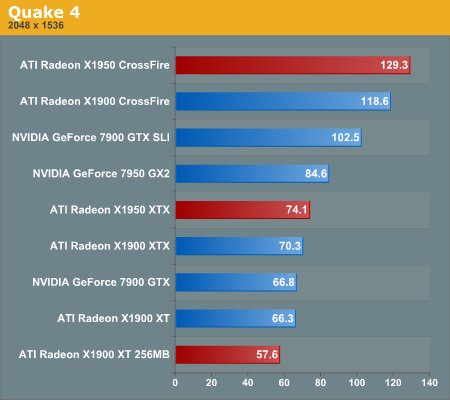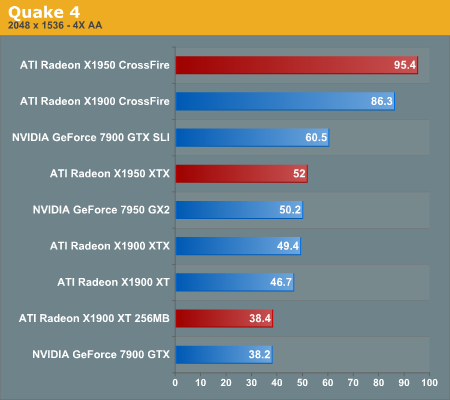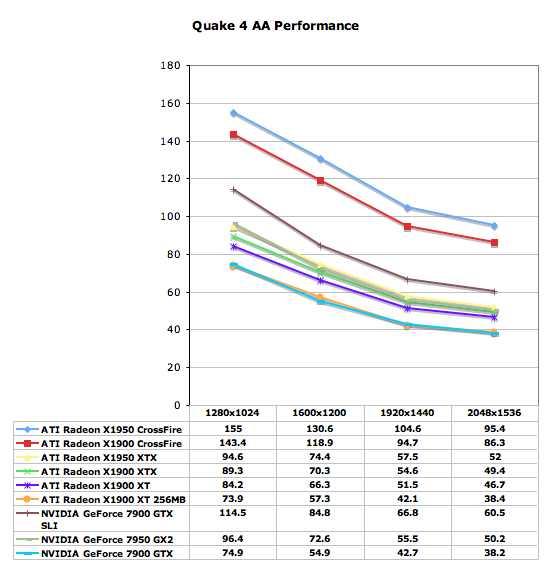ATI's New High End and Mid Range: Radeon X1950 XTX & X1900 XT 256MB
by Derek Wilson on August 23, 2006 9:52 AM EST- Posted in
- GPUs
Quake 4 Performance
There has always been a lot of debate in the community surrounding pure timedemo benchmarking. We have opted to stick with the timedemo test rather than the nettimedemo option for benchmarking Quake 4. To be clear, this means our test results focus mostly on the capability of each graphics card to render frames generated by Quake 4. The frame rates we see here don't directly translate into what one would experience during game play.
Additionally, Quake 4 limits frame rate to 60 fps during gameplay whether or not VSync is enabled. Performance characteristics of a timedemo do not reflect actual gameplay. So why do we do them? Because the questions we are trying to answer have only to do with the graphics subsystem. We want to know what graphics card is better at rendering Quake 4 frames. Any graphics card that does better at rendering Quake 4 frames will play Quake 4 better than other slower cards. While that doesn't mean the end user will see higher performance in the game, it does mean that the potential for seeing more performance is there, for instance if the user upgrades a CPU before the next graphics card upgrade.
Timedemos do walk a fine line between synthetic benchmarks and real world benchmarks. While we tend to favor real world data here at AnandTech, this type of benchmark is very capable of using a real world data set to test the maximum capabilities of the graphics cards under its particular work load without bottlenecking at other points in the system. To be sure, even timedemos can see memory and CPU bottlenecks, as data must be transfered to the graphics card some how. But this impact is much lower than the impact of running AI, physics, script management, I/O, and other game code at the same time.
What this means to the end user is that in-game performance will almost always be lower than timedemo performance. It also means that graphics cards that do slightly better than other graphics cards will not always show a tangible performance increase on an end user's system. As long as we keep these things in mind, we can make informed conclusions based on the data we collect.
Our benchmark consists of the first few minutes of the first level. This includes both inside and outdoor sections, with the initial few fire fights. We test the game with Ultra Quality settings, and we enable all the advanced graphics options except for VSync and antialiasing. Anisotropic filtering is manually set to 8x. Id does a pretty good job of keeping framerate very consistent; in-game framerates of 25 are acceptable. While we don't have the ability to make a direct mapping to what that means in the timedemo test, our experience indicates that a timedemo fps of about 35 translates into an enjoyable experience on our system. This will certainly vary on other systems, so take it with a grain of salt. But the important thing to remember is that this is more of a test of relative performance of graphics cards when it comes to rendering Quake 4 frames -- it doesn't directly translate to Quake 4 experience.

The Doom 3 engine was once NVIDIA's stomping grounds, but Quake 4 performance is now dominated by ATI's Radeon X1900 and X1950 series. The X1950 CrossFire manages a 26% performance advantage over the GeForce 7900 GTX SLI, while the X1900 CF setup pulls ahead by just under 16%.
Among single cards, the X1950 XTX manages about an 11% performance advantage over the 7900 GTX, meaning that CrossFire actually scales much better than SLI in Quake 4 for some reason. The new 256MB X1900 XT is outperformed by its 512MB sibling by a decent 16%. Honestly we were not expecting to see such big differences, especially with AA disabled, between the 256MB and 512MB cards. It's good to see that games are actually using all of this framebuffer being thrown at them.


With AA enabled, ATI does even better, with the X1950 CrossFire outperforming the 7900 GTX SLI by over 57%. ATI has done a lot of work on its OpenGL performance lately and we're currently investigating to see if that's the cause for such a stellar showing in Quake 4 here today.











74 Comments
View All Comments
nextsmallthing - Wednesday, August 23, 2006 - link
Did anyone else notice that the specs for some of the NVIDIA cards are wrong? For example, the core clock of the 7900GTX is supposed to be 650 MHz, not 700 MHz, and the core clock of the 7900GT should be 450 MHz, not 470 MHz. Also, the pipeline configuration for the 7300GT (according to Wikipedia anyway) should be 8 pixel & 4 vertex.This many mistakes really makes me question the accuracy of other specs I read on Anandtech.
(And by the way, would somebody please inform the DailyTech writers that it's "Xbox 360", not "XBOX 360". And yes I'm aware of the conventions that punctuation goes inside quotes and you shouldn't start sentences with "and".)
Anand Lal Shimpi - Wednesday, August 23, 2006 - link
The 7900GTX/GT clock speeds that were listed were actually vertex clock speeds, not general core clock speeds, so they were technically correct (parts of the GPU do run at those frequencies) just not comparable to the other numbers. They have been corrected.The 7300GT is indeed 8 pipes, that was a copy/paste error. Thanks for the heads up.
Take care,
Anand
nextsmallthing - Thursday, August 24, 2006 - link
Wow--prompt correction and courteous reply. I'm impressed, and my faith in Anandtech is restored!Josh7289 - Wednesday, August 23, 2006 - link
From the looks of the pricing structure for ATI's cards on the first page, and especially from the looks of the pricing structure for ATI's cards after they simplify their lineup, it looks like ATI is giving up on midrange cards, from $100 - $200. The 7600GT and the upcoming 7900GS both are alone in that price range (about $150 and $200, respecitively), with no competition from ATI, so it seems they really are giving that price range to Nvidia.Am I right with this or am I seriously missing something?
yyrkoon - Wednesday, August 23, 2006 - link
there is a x1800GTO2, price last I looked was around $230, of course, they released it rather quietly. Still, thats about $90 higher than the 7600 GT (or in my case the eVGA 7600GT KO).OrSin - Wednesday, August 23, 2006 - link
I wondering the same thing. Are they going to stop making any 1800's. They should be dropping in this price range nicely. Not sure how competative they are with the 7900's. And now that the 7900GS is coming out the 1800 might be just too outclassed. (you guys just missed a great deal on woot 7900GS for $145).I hope 1800 drop is still being made and I hope it drops to $150-180 range to fill that gap.
JarredWalton - Wednesday, August 23, 2006 - link
I think they've already stopped making all of the X1800 series, but there are still cards floating around.Josh7289 - Wednesday, August 23, 2006 - link
The X1900GT is a card meant to compete with the stock 7900GT, and as such is somewhere around the $200 - $250 price range.As for the X1950 Pro and X1650 XT, what are these supposed to compete against and at what prices. More importantly, when are these supposed to launch?
coldpower27 - Wednesday, August 23, 2006 - link
As well the X1650 XT is also in the works.coldpower27 - Wednesday, August 23, 2006 - link
X1950 Pro, is upcoming, as well they still have the X1900 GT.